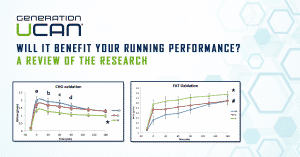Over the past several weeks, we’ve had a lot of articles on the various aspects of fueling for the marathon, including: does carbo loading work, how to calculate electrolyte loss, the best fueling sources for the marathon, a 3-step process to determine your refueling needs, and how to calculate when you’ll hit the wall.
To run your best, it’s vital that you arrive at the starting line well-prepared and have a race plan that doesn’t neglect keeping your body’s carbohydrate stores high so you don’t hit the wall before the finish.
There are certain guidelines that should be followed for increasing your body’s carbohydrate stores before the race, choosing the right kinds of fuel to consume during the race, and planning out a schedule of how much and how often you should refuel during your marathon, plus how early into the race you should start.
This can seem like a dizzying combination of factors to take care of, and it would be hard to blame yourself if you feel lost already.
Fortunately, in the world of running, there is always one fallback when you’re not sure what to do: look up what elite runners do! In this article, we’ll examine the research and practical examples of the refueling strategies of elite marathoners so you can see an example plan in action.
How elite runners refuel
Elite times in the marathon have been dropping at an incredible rate over the last few decades. Certainly, much of this is due to improvements in training methods and a more talented slew of runners taking to the roads, but better fueling almost definitely has an impact as well.
How elites used to fuel
According to legend, Spyridon Louis, the winner of the very first modern Olympic marathon in 1896, consumed nothing during his race, save for a single glass of wine.
As recently as the 1970s, it was believed in some corners that refueling during a marathon was unhelpful. It’s telling that elite runners today who are moving up to the marathon spend a significant amount of time considering their fueling strategy.
But things have changed as our understanding of nutrition an exercise science have improved dramatically.
Differences between elite marathoners and you (does it matter when it comes to fueling?)
Now, recreational and modestly competitive runners face some challenges that elite runners don’t.
First, elite runners don’t weight very much and aren’t carrying much extra body weight. This means they require fewer calories per mile of running than a more generously-proportioned runner who’s perhaps got a bit of “hibernation weight” around his or her stomach.
But this is offset by the fact that elite athletes run at a very high percentage of their VO2 max, meaning a greater portion of their calories must come from carbohydrates.
Additionally, they have a lot less time to ingest calories while running.
Mathematical models of “hitting the wall” predict a 3:30 marathoner and a 2:10 marathoner running at the same intensity relative to their fitness level will hit the wall at around 20-21 miles into the race. The difference is that the elite runner arrives at that point in about an hour and 45 minutes, while the middle-of-the-pack runner takes almost three hours to get there.
Your ability to absorb carbohydrates is independent of your running fitness, so you can see why elites pay so much attention to their fueling plan.
The other drawback of not being an elite runner is that you don’t get to submit your own personal fueling plan to the race director—you’ve got to make do with what’s available at the race. There are some workarounds for this, like carrying gel packets with you, but in general you’ll have to plan your own fueling around what is provided at aid stations.
With all of this in mind, let’s take a look at how a few elite runners approach fueling in training and on race day.
Training and race day refueling the elite way
A 2012 scientific report by Trent Stellingwerff at the Canadian Sport Institute details the training and race-day fueling plans of three marathoners who would go on to run personal bests of 2:11, 2:12, and 2:16 in their marathons following the case study.
Stellingwerff writes that all three runners used “low-CHO [carbohydrate] availability training” 3-5 times during preparation for the race.
Here is the step-by-step training nutrition protocol they followed during training, before the race, and during the competition:
Nutrition in training
- The elites practiced glycogen depleted runs before key workouts and long runs early in the training cycle. This was usually accomplished by running first thing in the morning without eating any food and drinking only water or coffee. These were done to steel the body against the fatiguing effects of carbohydrate depletion that can occur late in the marathon.
- As their marathon approached, the runners worked to practice refueling during their marathon workouts and long runs. They were instructed to gradually increase their rate of carbohydrate ingestion in training until they were able to tolerate at least 60 grams of carbohydrates per hour—Stellingwerff cited research showing that higher intake rates of refueling solutions (sports drinks or gels) with both glucose and fructose produced superior results than lower rates of carbohydrate intake or solutions containing only glucose.
Nutrition in the weeks leading up to the race
- In the final weeks of training, the runners ate a high-carbohydrate diet and practiced consuming carbs during training very often. This was done both to top off the body’s carbohydrate reserves and to avoid any potential GI distress on race day from an unfamiliar fueling strategy.
Nutrition during the race
- During the actual marathon race, the athletes all aimed to take in at least 60g of carbohydrates per hour. They accomplished this by consuming 15g of carbohydrates and 150 mL (5 fluid ounces) of water every 15 minutes throughout the entire race.
- This was accomplished by a combination of sports drinks, water, and gel packets. By tallying up the total fluid and carb intake, Stellingwerff determined that the three runners actually consumed 49, 56, and 77 grams of carbs per hour and between 16-26 fluid ounces of liquid per hour.
You might not be able to achieve quite the same precision with your marathon fueling plan—perhaps your local race only has aid stations every four miles, or maybe you don’t have the time to get up and run first thing in the morning several times a week—but nevertheless, the fueling preparations of the three elite marathoners described above should give you a better impression of how all the science on marathon fueling comes together in the real world.
Occasionally training with low carbohydrate stores, practicing refueling during workouts and long runs, picking the right fueling options, and following a pre-determined fueling plan on race day came together for these elite marathoners, and it can come together for you, too.
What is your strategy for your next marathon? Does it look like what these elites are doing?









One Response
Excellent Ebook marathon nutrition I did follow the advice in the book I would really recommand the book and any other advice in jason’sbook.